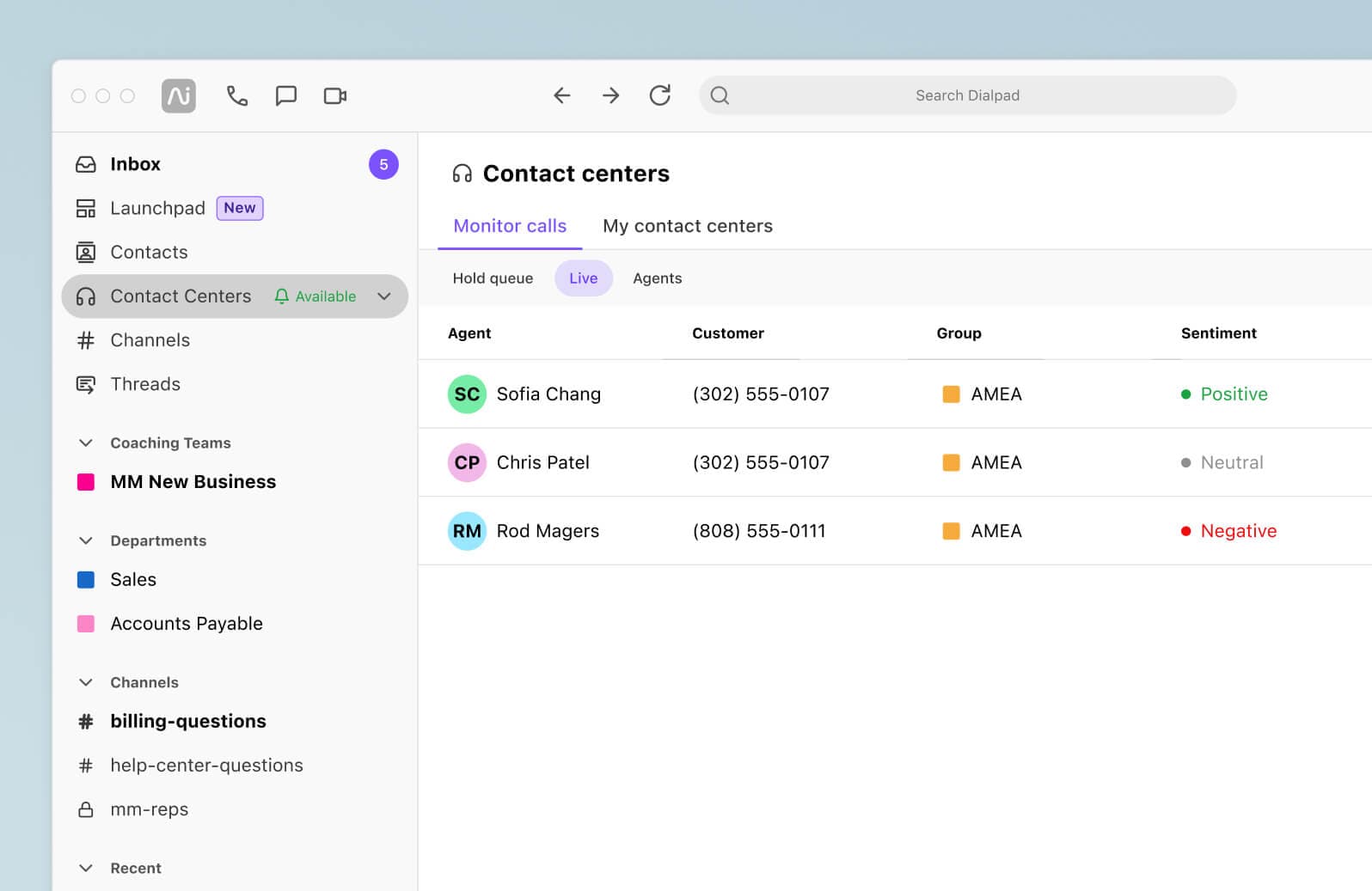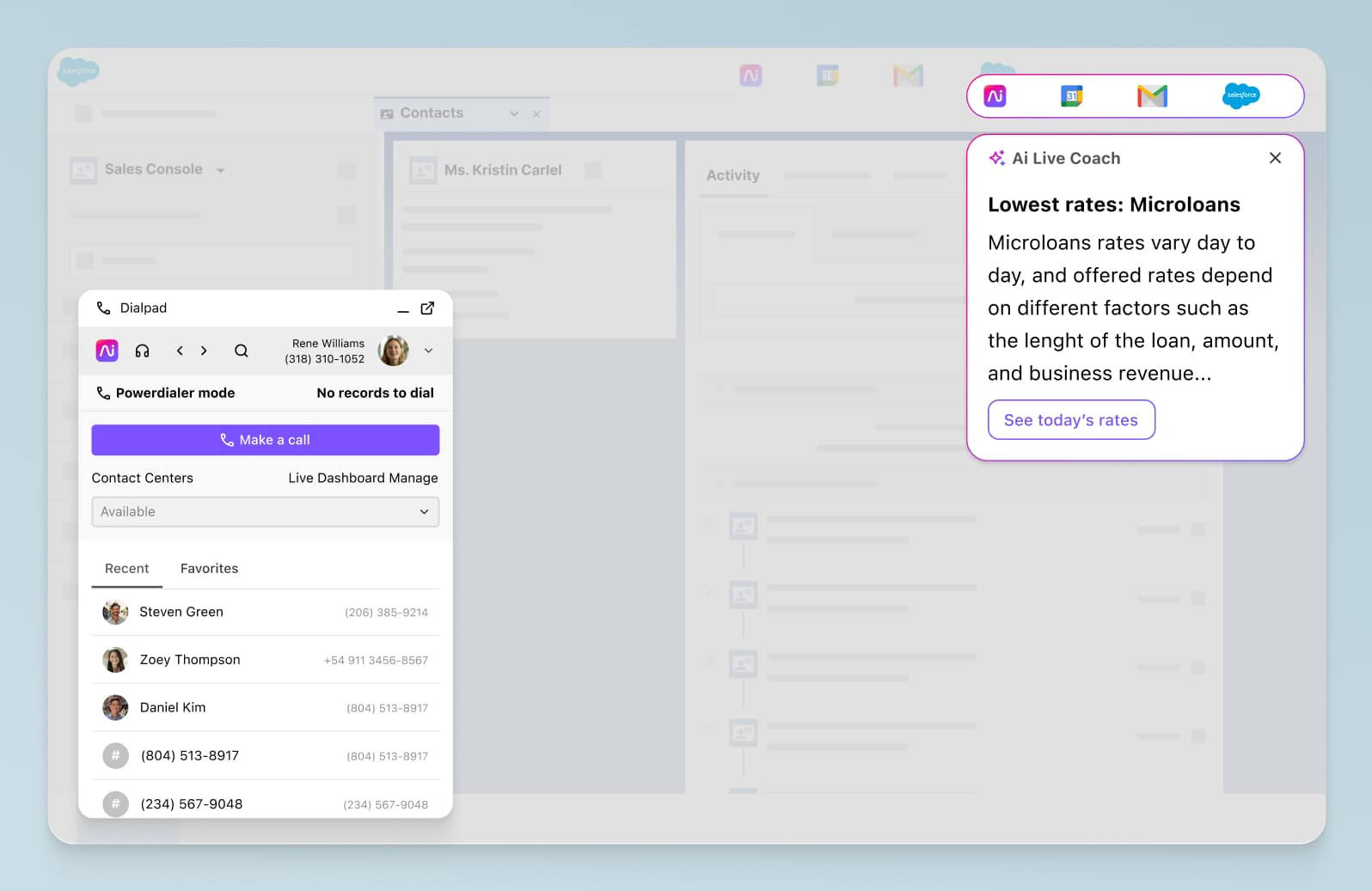How AI is changing call centers (and 5 things to do)

VP of Customer Experience

Tags
Share
Call centers have long been environments where innovation thrives. From high-tech audio hardware to custom software solutions, savvy call centers leverage tech to make operations run smoother and improve the customer experience.
It makes sense, then, that in the present day, cutting-edge technologies like artificial intelligence (AI) stand poised to revolutionize these environments and transform how customers and call center agents interact.
Machine learning, natural language processing, and other forms of Dialpad Ai can provide your call center with tremendous advantages — provided you understand how the technology can streamline workflows and boost efficiency.
Let's talk about the most exciting ways in which AI and customer service contact centers intersect for the better.
Webinar: Discover how Ai can transform your contact center
Learn how Ai can reduce wait times, boost efficiency, support agents and deliver an exceptional customer experience.
The evolution of AI in call centers and how it’s changed them
AI has revolutionized the way call centers operate in quite a few ways already—and it's not a big reach to say that there will likely be even more improvements that we haven't imagined yet!
So far, here are a few key key stages of AI's evolution in call centers:
From manual to automated call routing: Today, AI-powered systems can analyze incoming calls and use algorithms to determine the most suitable agent to handle the specific query. This eliminates the need for manual call transfers and reduces wait times, ensuring customers are instantly connected to the best agent to answer their questions.
From human intervention on every customer question to virtual agents: Virtual agents, or chatbots, or conversational AI, leverage Natural Language Processing (NLP) and Machine Learning (ML) algorithms to understand and respond to customer queries in real-time. These intelligent chatbots can provide instant answers without customers having to wait for hours on hold, allows human agents to focus on questions that actually need their input.
From manual QA to AI-assisted reviews and speech analytics: Before, a call center supervisor would have to listen to their agents' call recordings from beginning to end to do performance reviews and QA scoring. Today, AI-powered speech analytics tools can analyze call recordings and transcripts to speed up this time-consuming process by suggesting whether the agent fulfilled the QA scorecard criteria. Not only that, AI can also do this instantly for all of an agents' calls, which means a supervisor doesn't have to pick calls at random to review—and reduces the chances of an unfair QA review because a manager randomly chose a really bad call to review.
📚 Further reading:
Check out Dialpad's State of AI in Customer Service Report for the latest insights about AI's impact on businesses and contact centers, based on a survey of over 1,000 CX professionals.
5 ways call centers can use AI to empower agents and supervisors
1. Improve call routing
It wasn't that long ago that skills-based routing systems were a fresh concept, using customer profiles to pair callers with an agent whose skills were up to the task of assisting them. Increasingly, AI and customer service automation can drastically speed up the process of determining which agent to assign to a call.
Today, contact center software with intelligent call routing systems can use self-learning algorithms to analyze customer personality models, previous call histories, and behavioral data. It then uses that info to determine the best manner in which to handle calls—sending simple, routine requests to support chatbots if possible and routing calls to live agents only when the nature of the request is of sufficient complexity to require a human touch.
In those cases, AI can use the information at its disposal to route calls to the best-equipped agents to deal with specific types of customers and queries, ensuring that tickets are closed quickly and effectively and free up time across the board.
Over time, this technology becomes more effective at making successful matches, which allows you to better respond to customers and improve their overall experience consistently.
2. See call analytics instantly
There's a wealth of information in every customer interaction, and call center AI is the key to capturing it all.
For example, live sentiment analysis can provide hints on how people feel about your brand, service, or products based on the words they use. Dialpad Support doesn't just transcribe customer calls in real time—it can also pick out positive and negative sentiment-related words and show supervisors which calls might need them to step in and help an agent with an irate customer:

With features like Natural Language Processing (NLP) and speech analytics, you can record customer service interactions and have them transcribed in an easy-to-read format. Transcriptions make it easy for supervisors to review conversations at a glance, pick up necessary details, and spot areas where agents need more coaching. (Learn more about NLP in customer service.)
AI can assist with contact center analytics, which provides the opportunity to spot trends across large sets of customer data while providing insights on whether or not your customers are angry, happy, or dissatisfied. Supervisors can then adjust their strategies for interfacing with customers and improve their services to deliver a better experience.
3. Get a better grasp of customer behavior
Building off of call analytics, AI can make customer interactions more effective in several ways. For starters, the trends in customer behavior that AI can identify will provide the early insight that call centers require to predict emerging customer needs and quickly develop best practices around them.
What's more, AI can make detailed customer information and behavioral profiles available to all your agents. This information helps customer service teams anticipate customer needs and quickly adjust their approach to customer retention, upsell and cross-sell, or other specific actions in every customer interaction.
4. Empower agents with real-time response suggestions
What's the best way to respond to large volumes of customers? While AI might not formulate complete, perfect responses for every scenario, it's more than capable of assisting agents in responding more appropriately in a wide range of situations.
Dialpad's RTA (Real-Time Assist) cards and Ai Live Coach features, for instance, can provide live feedback about the flow of a conversation and also search knowledge bases in real time to pull answers to challenging questions for agents who might be new or still ramping up:

Additionally, you can use this technology to ensure that conversations adhere to your internal standards and alert managers when conversations veer from the appropriate course and may require either intervention or follow-up action. This will improve customer call quality over time, help you further refine best practices, and reduce instances of churn and dissatisfaction among callers and customers.
5. Facilitate self-service and call deflection options
AI can't replace everything that a human agent can do, but it is often sufficient to reach a satisfactory resolution for simple requests. You can leave routine, day-to-day questions, and other fundamental interactions that might fall under the banner of "self-service" to AI. Help your callers complete simple tasks like placing an order, checking a balance, or paying a bill on their own, so your human agents are free to respond to more complex calls.
There is also a potential for AI to take on more significant self-service automations. This depends on having accurate data so that AI can correctly automate its responses to customers. Incomplete information limits the ability of AI to manage more complicated interactions. Prioritizing data and analytics will be essential if you want AI to play a larger role in responding to customers and providing more significant degrees of self-service.
In Dialpad Support, supervisors can easily set up conversational AI dialogs with the drag-and-drop builder, no coding needed:

Have you explored these call center AI use cases?
Though the specifics vary, the primary use cases for AI in call centers fall into a few main areas:
Automating data collection and routine processes to free up human agents
Analyzing call center data to provide insights on customers and refine strategies
Supporting service agents by improving response times and quality (Learn more about conversational AI in customer service)
Though the development of many call center AI features is still relatively recent—within the last several years—you can observe their impacts based on the continued adoption and refinement of such technologies by large entities in both the foodservice and banking industries.
While AI technologies will never replace humans in customer service and call center roles entirely, they are set to take on more of the monotonous work. Support humans in carrying out their functions more effectively is one of the many reasons why AI is good in the workplace.
4 best practices for implementing AI in a call center
1. Define clear objectives
Determine the specific goals you want to achieve with AI implementation. That might be reducing call volumes, improving first call resolution rates, or improving your customer satisfaction scores. AI tools can do a huge variety of tasks, and having clear objectives will help you choose the right AI tools for your particular org.
2. Integrate it with your other tools
Ensure the AI systems seamlessly integrate with your existing call center infrastructure and software. Having tools that natively integrate together enables automatic data sharing, makes it easier for agents to access customer insights in one centralized app, and just improves overall efficiency.
For example, Dialpad Support integrates with CRMs (Customer Relationship Management platforms) like Salesforce to transcribe calls in real time and pop up AI-powered agent assists—right inside Salesforce:

3. Give your agents adequate training and support
Your agents and supervisors will be the ones using these AI tools every day, so make sure to provide comprehensive training and support that will empower them to effectively leverage these AI tools. Just like with adopting any new software, it's normal to sometimes see resistance—especially when your agents are already busy handling high-pressure customer conversations—and it's crucial that you get ahead of this and make this process as easy and frictionless as possible for your team.
4. Continuously monitor progress and optimize where you can
Now, we've come full circle back to our first best practice. To truly be able to report success in adopting or leveraging AI in your call center, you have to be able to point to metrics or other call center KPIs that prove this out—how have agent efficiency, customer feedback, and overall productivity changed?
Know which metrics you're measuring against, and analyze the data to identify areas for improvement and refine your strategy accordingly.
AI in your call center: How will you use it?
Even though it's relatively early, AI has already drastically changed how we operate call centers.
From making agents more efficient, to improving the customer experience and improving the quality of data we can collect, AI technologies can make our lives easier (whether we're agents, supervisors, or business leaders) in a wide range of ways.
See how Dialpad Support can help you do this!
Use Dialpad Ai to improve your call center performance
Book a demo or take a self-guided interactive tour of the app to see how it works!
